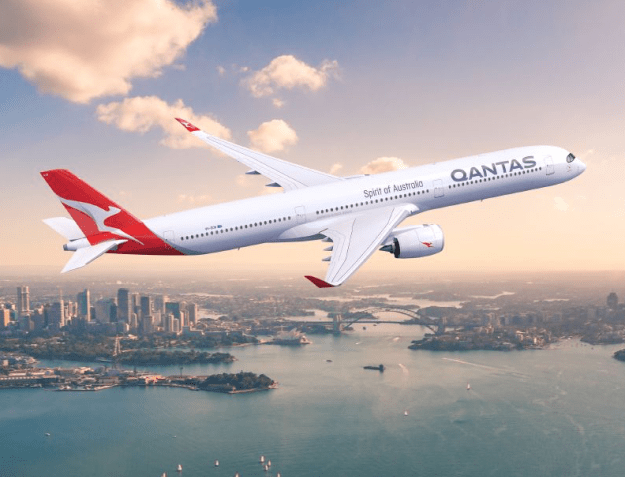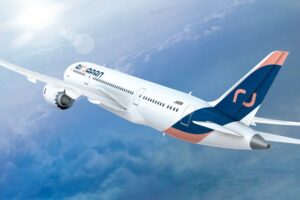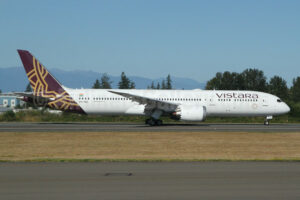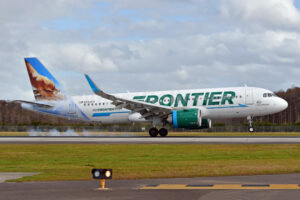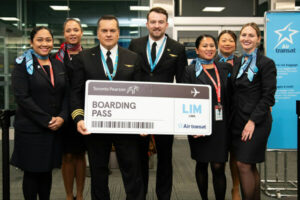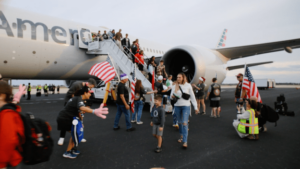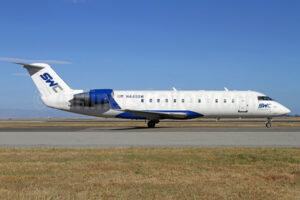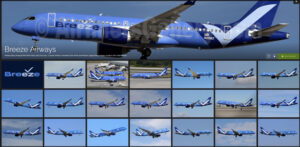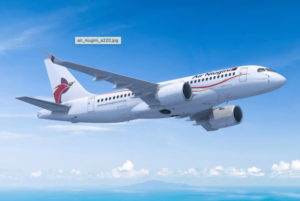QANTAS made this announcement:
The Qantas Group has today announced the final piece of its jet fleet renewal program with a firm order for 24 aircraft to progressively replace its existing A330s.
The multi-billion dollar order is split between 12 Airbus A350s and 12 Boeing 787s arriving from FY27 into the next decade. The Group has also negotiated additional purchase right options, split evenly between both manufacturers, to give flexibility for future growth and ultimately replace its 10 A380s with A350s from around FY32 onwards.
Qantas’ A330 aircraft mostly operate on international flights to Asia and the United States as well as some domestic flights. The longer range delivered by the 787 and A350 aircraft on order means they will be able to operate all the routes on the airline’s current international network, as well as open up new ones.
The average age of Qantas’ A330 fleet will be 21 years at the time the replacement program starts in FY27, which is in line with the Group’s typical replacement profile. Aircraft scheduled to leave the Qantas fleet towards the end of the replacement program will undergo a cabin refurbishment from FY25, including next-generation seats in the Economy cabin.
Qantas has named its international fleet renewal ‘Project Fysh’ in honour of Sir Hudson Fysh who co-founded the airline and was Managing Director when it commenced international flying in 1935.
SUSTAINABLE AVIATION FUEL AGREEMENT
As part of the deal with both Airbus and Boeing, Qantas will secure access to up to 500 million litres of Sustainable Aviation Fuel (SAF) per annum that would start to flow from 2028[1].
This has the potential to meet up to 90 per cent of the Group’s interim SAF target for 2030.
As a direct alternative to traditional jet kerosene, SAF reduces lifecycle carbon emissions by up to 80 per cent and is a key part of Qantas’ emissions reduction plan.
Access to these supplies will be enabled by partnering with Boeing and Airbus on SAF projects, including in the United States. Qantas expects to purchase the SAF at favourable prices due to supportive government policies in the US.While these agreements support the Group’s interim targets, access to an Australian SAF industry is critical to reaching the industry’s broader commitment to reach net zero by 2050.Qantas has previously announced a $400 million climate fund aimed at investing in similar projects locally to help kickstart a domestic SAF industry in Australia.
ABOUT THE ORDER
- Firm order for four Boeing 787-9 and eight 787-10 aircraft, with deliveries starting in FY27.
- Firm order for 12 Airbus A350-1000s, with deliveries starting in FY28.
- Purchase right options split between Airbus and Boeing to complete A330 and A380 fleet replacement and provide for growth.
- Both orders include significant flexibility to adjust the timing of deliveries.
ABOUT THE AIRCRAFT
Boeing 787-9 and 787-10
- Qantas’ 787-9 at 62.8 metres is around the same length as the A330s they will replace, while the 787-10 at 68.3 metres is around five metres longer.
- Both 787 models will be powered by General Electric GEnx engines.
- The noise footprint of the 787 is 60 per cent smaller than those of previous generation aircraft[2].
- The 787-9 delivers a 20 per cent improvement in fuel use, and around 25 percent for the 787-10, as compared to previous generation aircraft[3].
Airbus A350-1000
- Qantas’ A350-1000 at 72.25 metres is 8.5 metres longer than the A330s they will replace and the same length as the A380.
- The aircraft will be powered by Rolls Royce Trent XWB-97 engines.
- The A350 provides a 50 per cent noise footprint reduction from previous generation aircraft[4].
- The A350 enables a 25 per cent advantage in fuel burn and CO2 emissions compared to previous generation aircraft[5].
QANTAS GROUP FLEET RENEWAL OVERVIEW
- The Qantas Group is on track to receive the first two QantasLink A220 aircraft by the end of this calendar year; subsequent deliveries are expected to be delayed by up to four months as a result of supply chain disruption.
- The first of seven mid-life A320 family aircraft to meet growing resources flying and Jetstar Asia recovery are expected to arrive before the end of December 2023.
- Twenty-two of the previously announced E190s wet-leased from Alliance Airlines are scheduled to have joined the Qantas fleet by the end of December 2023.
- Two more A321 converted freighters are expected to arrive by the end of December 2023.
- Jetstar’s 18 Airbus A321LRs are on track to enter the fleet by the end of calendar year 2024, with a further 20 A321LRs and A321XLRs set to be delivered by calendar year 2029.
- The first of 12 Airbus A350-1000 ULRs for Project Sunrise are due to arrive in FY26.
[1] Based on meeting certain criteria under Airbus and Boeing deals, including partnership with the manufacturers on SAF projects. The agreement includes ~80 million litres of SAF per annum from existing projects. The remaining volume will be sourced through investment in new projects.
[2] Source: https://www.boeing.com/aboutus/environment/environmental_report_09/_inc/flash-2-3-2.html
[3] Source: https://www.boeing.com/commercial/787/#
[4] Source: Airbus A350 Facts and Figures, April 2023
[5] Source: Airbus A350 Facts and Figures, April 2023
- SEO Powered Content & PR Distribution. Get Amplified Today.
- PlatoData.Network Vertical Generative Ai. Empower Yourself. Access Here.
- PlatoAiStream. Web3 Intelligence. Knowledge Amplified. Access Here.
- PlatoESG. Automotive / EVs, Carbon, CleanTech, Energy, Environment, Solar, Waste Management. Access Here.
- PlatoHealth. Biotech and Clinical Trials Intelligence. Access Here.
- ChartPrime. Elevate your Trading Game with ChartPrime. Access Here.
- BlockOffsets. Modernizing Environmental Offset Ownership. Access Here.
- Source: https://worldairlinenews.com/2023/08/23/qantas-orders-12-airbus-a350-1000s/
- :has
- :is
- $400 Million
- $UP
- 1
- 10
- 12
- 20
- 2023
- 2024
- 2030
- 2050
- 24
- 25
- 39
- 50
- 500
- 60
- 72
- 8
- 80
- 90
- a
- A380
- Able
- access
- Additional
- adjust
- ADvantage
- age
- Agreement
- agreements
- aimed
- Airbus
- aircraft
- airline
- Airlines
- All
- Alliance
- also
- alternative
- an
- and
- announced
- Announcement
- annum
- April
- ARE
- around
- arriving
- AS
- asia
- At
- Australia
- Australian
- average
- aviation
- based
- BE
- before
- between
- Boeing
- both
- broader
- burn
- by
- Calendar
- carbon
- carbon emissions
- certain
- chain
- Climate
- co2
- co2 emissions
- COM
- commitment
- compared
- complete
- converted
- criteria
- critical
- Current
- deal
- Deals
- decade
- December
- Delayed
- delivered
- Deliveries
- delivers
- direct
- Director
- Disruption
- Dollar
- Domestic
- due
- economy
- Electric
- Emissions
- enabled
- enables
- end
- Engines
- Enter
- evenly
- existing
- expected
- expects
- facts
- family
- Figures
- final
- Firm
- First
- five
- FLEET
- Flexibility
- Flights
- flow
- flying
- Footprint
- For
- four
- from
- Fuel
- fund
- further
- future
- future growth
- General
- General Electric
- generation
- Give
- Government
- Group
- Group’s
- Growing
- Growth
- Have
- help
- High
- HTML
- HTTPS
- improvement
- in
- include
- includes
- Including
- industry
- industry’s
- International
- into
- investing
- investment
- IT
- ITS
- joined
- Key
- Leave
- Length
- lifecycle
- Line
- locally
- longer
- made
- managing
- Managing Director
- Manufacturers
- max-width
- means
- Meet
- meeting
- million
- models
- months
- more
- mostly
- Named
- negotiated
- net
- network
- New
- next
- next-generation
- Noise
- of
- on
- ones
- open
- operate
- Options
- order
- orders
- part
- partnering
- Partnership
- per
- percent
- piece
- plan
- plato
- Plato Data Intelligence
- PlatoData
- policies
- potential
- powered
- previous
- previously
- Prices
- Profile
- Program
- progressively
- project
- projects
- provide
- provides
- purchase
- range
- reach
- reaching
- receive
- recovery
- reduces
- reduction
- remaining
- replace
- replacement
- Resources
- result
- right
- rolls
- routes
- same
- scheduled
- secure
- set
- seven
- significant
- similar
- Sir
- smaller
- some
- Source
- sourced
- split
- start
- Starting
- starts
- States
- subsequent
- supply
- supply chain
- support
- supportive
- sustainable
- sustainable aviation fuel
- Target
- targets
- than
- that
- The
- These
- they
- this
- those
- Through
- time
- timing
- to
- today
- towards
- track
- traditional
- two
- typical
- Ultimately
- under
- undergo
- United
- United States
- us
- use
- volume
- was
- WELL
- when
- which
- while
- WHO
- will
- with
- would
- year
- years
- zephyrnet
- zero

